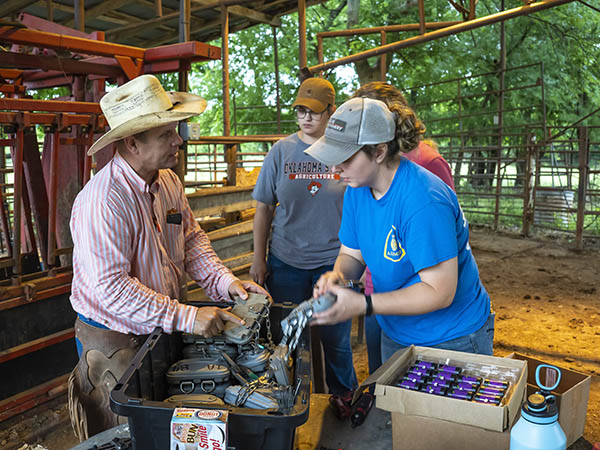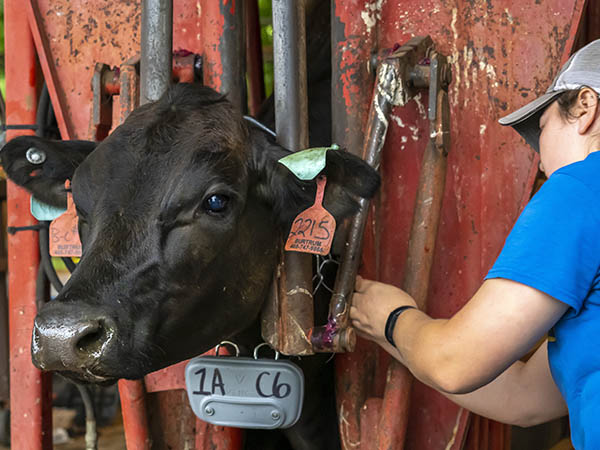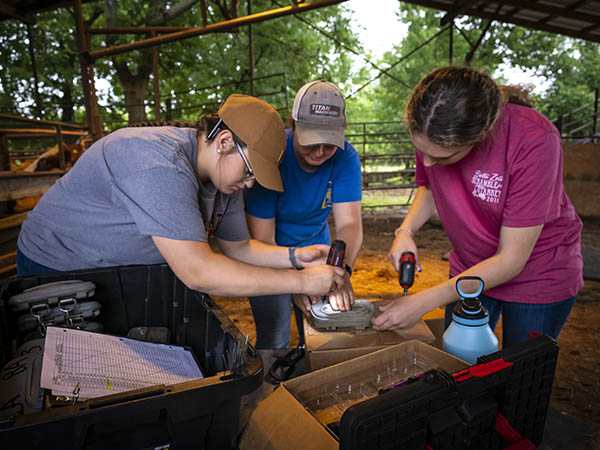
OSU virtual fencing research advancing with $1.4 million USDA grant
Thursday, July 7, 2022
Media Contact: Alisa Boswell-Gore | Agricultural Communications Services | 405-744-7115 | alisa.gore@okstate.edu
Oklahoma State University researchers are taking their research on virtual fencing technology to the next level this fall thanks to a $1.4 million grant from the U.S. Department of Agriculture-Natural Resources Conservation Service.
“We’re looking at how managed grazing with virtual fencing can improve grazing distribution, pasture biodiversity and productivity, and wildlife and pollinator habitat,” said Ryan Reuter, professor of range beef cattle nutrition in the OSU Department of Animal and Food Sciences.
OSU researchers have spent the last year studying the grazing patterns of cattle through GPS-enabled collars as part of an $800,000 Environmental Protection Agency grant. The collars allow producers to not only see where their cattle are grazing, but also manage where they graze. The collars emit two stages of auditory ques before the final prompt of a small electrical stimulus.
A pilot project in 2019 introduced the technology to obtain initial results, Reuter said. Researchers observed where a group of cattle liked to congregate for two weeks before implementing a virtual fence and exclusion zone on that spot for about 10 days. The experiment resulted in a 99% success rate at keeping cattle out of that zone.
Through the EPA grant, Reuter’s team studied the grazing habits of cattle in riparian zones (areas bordering bodies of surface water). The GPS collars were put into place at two OSU research locations and one private ranch. Researchers hope to add a second private ranch to the project this fall. OSU’s Department of Natural Resource Ecology and Management faculty have also been involved with the project.
“I am eager to see if the costs and the analytics prove this to be a viable tool for cow-calf producers,” said Clay Burtrum, owner of Burtrum Cattle, the private ranch participant. “Technology like this allows me to move my herd from wherever I am, and that could be very beneficial to producers, especially if they are like me and have a day job in town in addition to managing a cattle operation.”
The next phase of research with USDA-NRCS funding begins this fall and will involve Reuter and his fellow scientists using the collars to manage the grazing patterns of cattle. The grant also funds conducting the same research in upland areas (land at a higher elevation).
“We’ll have an exclusion zone around the riparian area so they can’t get down in the creek, and we will do some rotational grazing where we move cattle around the pasture to control their grazing patterns,” Reuter said. “We’re going to look at whether the water runoff quality improves when we do that.”
The team hopes to learn how much time the cattle spend in areas preferred by researchers versus how often they move into areas researchers want them to avoid. The study will also show how virtual fencing improves the grasslands environment where cattle graze.
“Water quality reports from the Oklahoma Department of Environmental Quality have shown poor grazing practices are impacting lakes, rivers and streams in Oklahoma,” said Kevin Wagner, professor and director of the Oklahoma Water Resources Center, who is working on the project with Reuter. “This technology will improve the quality of grazing lands, cattle production and water quality as ground cover, and the amount of time cattle spend in critical areas will be reduced.”
Other potential benefits of virtual fencing:
- Producers will have the ability to implement grazing management recommendations more easily without building physical fence.
- Depending on a producer’s stocking rates, the system could be more cost effective than building and maintaining physical fence. The cost of technology declines over time, so virtual fencing has the potential to be even more cost effective in the future.
- Virtual fencing gives producers the ability to exercise grazing management in areas where it would be difficult to build physical fence due to the terrain or soil type.
- For producers less able to do the physical work, the technology saves them from having to build fence and manage cattle grazing as often in person.
- Producers with outdated fencing that cattle can easily get through could use virtual fencing as a backup to their physical fencing.
- It allows producers to know where all their cattle are in real time, which can alert producers to problems with their cattle whether they are onsite or not.
“This virtual fencing system is probably going to go commercial within the three years we’re doing this project,” Reuter said. “There will be a lot of producers interested in applying it and who will have questions about it, so we will likely keep it as part of the management system at our research ranch so we can answer questions producers have about it.”
This work is supported by the Conservation Innovation Grants program at USDA’s Natural Resources Conservation Service.
This project has been funded by the U.S. Environmental Protection Agency under assistance agreement MX-02D00721-0 to Oklahoma State University. The contents of this document do not necessarily reflect the views and policies of the EPA, nor does the EPA endorse trade names or recommend the use of commercial products mentioned in this document.



